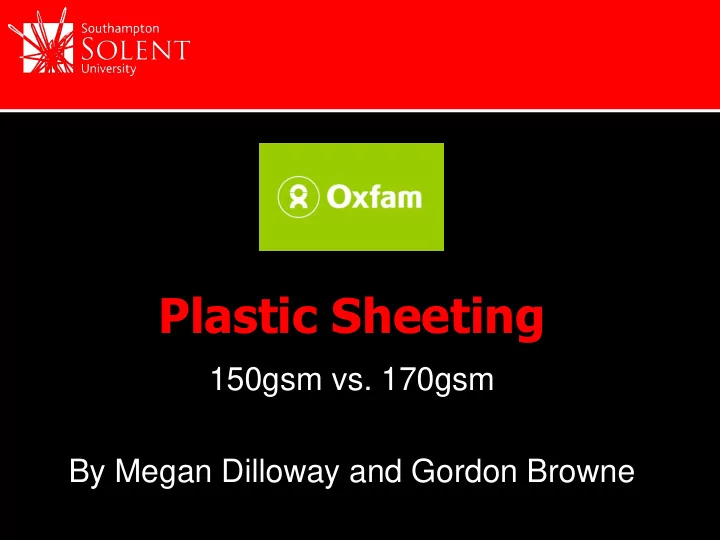

Plastic Sheeting 150gsm vs. 170gsm By Megan Dilloway and Gordon Browne
Background A manufacture is offering a lighter weight reinforced woven plastic sheet. Field and Laboratory tests have been initiated. Field tests are located in: • South Sudan • Zimbabwe • Bristol • Oxford Laboratory tests were conducted at Southampton Solent University.
Aim of Research Project To be able to produce a comparative table that may aid Oxfam in a decision on the use of the 150gsm plastic sheeting as a replacement of the currently used 170gsm.
Objectives 1. To conduct prolonged exposure field tests that replicate the locations in which it will be used. 2. To conduct laboratory tests to determine the tensile strength of the samples 3. To conduct laboratory tests to determine the tensile strength of the samples with exposure to high temperatures. 4. To construct laboratory tests to determine the strength of fixings currently in use and possible new fixing methods.
Exposure Testing 31st December 2012 – Field Test Started. Oxford Bristol 150gsm 170gsm
Exposure Testing – First Inspection 31st January 2013 – Inspection 1 (30 days). Oxford Bristol 150gsm 170gsm 150gsm 170gsm
Testing Standards Where possible the samples were tested in accordance with: BS EN ISO 13934-1:1999
150gsm vs. 170gsm 150gsm 170gsm
Pilot Test - Results The results from a pilot test established the rate at which the samples would be tested: • 20mm/min • 200mm/min The results lead to the decision that both rates would be used where appropriate to allow for a wider range of results.
Tensile Strength -Results The results obtained indicated that for both rates of testing the 150gsm performed better than the 170gsm.
Exposure to Heat Current emergencies: Syria and South-Sudan Maximum temperatures: Syria 46 C South-Sudan 42 C Plastic Sheeting was heated to a temperature between 45-50 C and then tested.
Exposure to Heat -Results
Exposure to Heat - Conclusion Result Conclusion: The plastics tensile strength is significantly lower when subject to high temperatures.
Fixing Methods Previous research into the different types of fixing was conducted by Solent University with Oxfam in 2007. The results obtained can be found at: http://www.plastic-sheeting.org/ These tests were repeated with the two samples of plastic.
Fixing Methods – Pilot Test Aim: To establish which rate should be used during the testing. Reason: T ime constraints . Fixing method: Plastic Eyelets Conclusion: 20mm/min Note: In both tests the plastic eyelet failed before the plastic sheeting.
Fixing Methods – Results Please note: The sample size for the stone method was double the width (100mm) compared with the other samples (50mm)
Conclusion Overall The 150gsm plastic sheeting has performed better than the 170gsm in all the preliminary tests. Further research: • Effects of heat on the plastic sheeting. The he En End Tha hank nk You ou for or Liste Listening ning
Recommend
More recommend